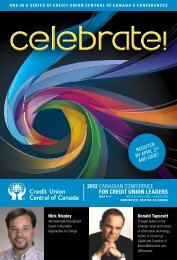A Practitioner’s Guide to Nudging
A Practitioner's Guide to Nudging - Credit Union Central of Canada
A Practitioner's Guide to Nudging - Credit Union Central of Canada
- No tags were found...
Create successful ePaper yourself
Turn your PDF publications into a flip-book with our unique Google optimized e-Paper software.
choosing, requiring individuals <strong>to</strong> make a mindful choice. One of the benefits of active<br />
choosing is that it promotes learning. However, it can lead <strong>to</strong> errors if the individual lacks<br />
the knowledge <strong>to</strong> make a good decision or feels that choosing is <strong>to</strong>o burdensome. An alternative<br />
<strong>to</strong> both nudges is <strong>to</strong> implement personalized default rules that are cus<strong>to</strong>mized <strong>to</strong> an<br />
individual’s needs and preferences.<br />
To help the choice architect decide which of these three nudges <strong>to</strong> implement, Sunstein<br />
makes the following recommendations.<br />
Default rules are preferred when:<br />
→<br />
→<br />
→<br />
Individuals prefer not <strong>to</strong> choose.<br />
The context is confusing and unfamiliar <strong>to</strong> the individual.<br />
Needs and preferences do not differ across the population.<br />
Active choosing is preferred when:<br />
→<br />
→<br />
→<br />
→<br />
→<br />
Individuals prefer <strong>to</strong> choose.<br />
The context is familiar <strong>to</strong> the individual.<br />
Needs and preferences vary across the population.<br />
Choice architects are not well informed.<br />
Learning is promoted, feasible, and beneficial.<br />
Personalized default rules are preferred over general default rules when heterogeneity<br />
exists and the needs and preferences of the population vary. It is preferred over active<br />
choosing when choice architects are well informed of the population’s needs and preferences<br />
and a suitable default rule can be chosen. Compared <strong>to</strong> active choosing, personalized<br />
default rules require less effort and time from the individual yet still preserve freedom of<br />
choice.<br />
Applying Behavioural Economics <strong>to</strong> Public Policy Using<br />
MINDSPACE<br />
A summary of MINDSPACE: Influencing Behaviour Through Public Policy (P. Dolan,<br />
M. Hallsworth, D. Halpern, D. King, and I. Vlaev, Institute for Government, March 2,<br />
2010, www.instituteforgovernment.org.uk/publications/mindspace)<br />
Traditional interventions in public policy are based on what people consciously think<br />
about and on the premise that behaviour can be shaped by providing information or altering<br />
incentives. It is assumed that individuals will analyze the information and incentives<br />
PAGE 26 SUMMARIES OF RELATED DOCUMENTS FILENE RESEARCH INSTITUTE



